Still life painting by the best artists. Still life - the image of inanimate objects. Paintings by genre
Still life(fr. nature morte - "dead nature") - the image of inanimate objects in fine arts, in contrast to portrait, genre, historical and landscape subjects.
The starting point of the early still life can be found in the XV-XVI centuries, when it was considered as part of a historical or genre composition. For a long time, the still life kept in touch with the religious picture, framing the figures of the Mother of God and Christ with flower garlands, and also often located on the reverse side of the altar image (as in Rogier van der Weyden's Triptych of the Marriage Family). Also in the 16th century, the tradition of creating portraits with the image of a skull was widespread, for example, the portrait of Jean Carondel by Jan Gossaert (see vanitas). Early still lifes often served a utilitarian function, such as decorating closet doors or masking a wall niche.
Still life finally takes shape as an independent genre of painting in the works of Dutch and Flemish artists of the 17th century. Objects in still life painting of this period often contain a hidden allegory - either the transience of everything earthly and the inevitability of death (Vanitas), or - in a broader sense, the Passion of Christ and the Resurrection. This meaning is conveyed through the use of objects - in most cases familiar and encountered in everyday life, which are endowed with additional symbolic meaning.
Netherlandish still life of the 17th century
The Dutch still life was a unique cultural phenomenon of the 17th century, which influenced the further development of all European painting. The “Little Dutchmen” reflected in their works the world of objects that live their own quiet, frozen life. The term "frozen life" (Dutch stilleven, German stilleben, English still-life) began to be used to refer to the genre in mid-seventeenth century, initially in the Netherlands. Prior to this, artists called such paintings, describing the plot: “Little Breakfast”, “Bouquet of Flowers”, “Hunting Trophy”, “Vanity of Vanities”. The main translation of the specified term, found in the literature - "quiet, motionless life."
Still life in Russian painting of the 18th-20th centuries
Still life as an independent genre of painting appeared in Russia at the beginning of the 18th century. The idea of him was originally associated with the image of the gifts of the earth and the sea, the diverse world of things surrounding a person. Until the end of the 19th century, still life, in contrast to the portrait and historical picture, was considered as an "inferior" genre. It existed mainly as an educational production and was allowed only in a limited sense as a painting of flowers and fruits.
The beginning of the 20th century was marked by the flourishing of Russian still life painting, which for the first time gained equality among other genres. The desire of artists to expand the possibilities of the pictorial language was accompanied by active searches in the field of color, form, and composition. All this is especially evident in the still life. Enriched with new themes, images and artistic techniques, Russian still life developed unusually rapidly: in a decade and a half, it goes from impressionism to abstract form creation.
In the 1930s and 1940s, this development stopped, but since the mid-1950s, still life has experienced a new upsurge in Soviet painting, and from that time on it finally and firmly stands on a par with other genres.
Russian naturmorists
- Khrutsky Ivan Fomich (1810-1885)
- Grabar Igor Emmanuilovich (1871-1960)
- Petrov-Vodkin Kuzma Sergeevich (1878-1939)
- Konchalovsky Pyotr Petrovich (1876-1956)
- Alberti Petr Filippovich (1913-1994)
- Antipova Evgenia Petrovna (1917-2009)
- Zakharov Sergey Efimovich (1900-1993)
- Kopytseva Maya Kuzminichna (1924-2005)
- Kotyants Gevork Vartanovich (1906-1996)
- Krestovsky Yaroslav Igorevich (1925-2003)
- Osipov Sergey Ivanovich (1915-1985)
- Pozdneev Nikolai Matveevich (1930-1978)
- Rumyantseva Kapitolina Alekseevna (1925-2002)
- Skuin Elena Petrovna (1909-1986)
- Teterin Viktor Kuzmich (1922-1991)
- Shamanov Boris Ivanovich (1931-2008)
In Russian pictorial art, still life has almost always been a secondary genre. And only sophisticated art critics will be able to name a domestic still life painter. But, one way or another, still life as an independent genre began to develop in the 19th century. The first "swallows" were small watercolors and gouaches by F.P. Tolstoy and the work of I.T. Khrutsky. These were classic European still lifes with lush bouquets of garden flowers and fruit baskets. For all their artistic charm, these works had a very limited value for the development of Russian painting.
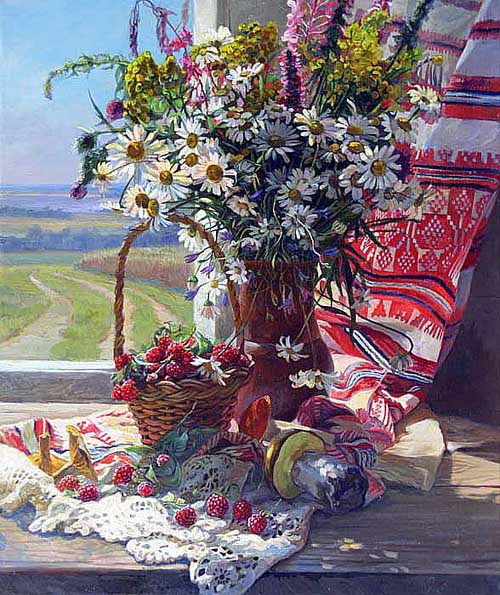
Interest in still life as an independent genre of painting appears in 80s of the 19th century. Paintings play an important role here. I.I. Levitan (1860-1900). They are usually simple in design and not large in size, and represent bouquets of familiar garden or wildflowers. In a still life Forest violets and forget-me-nots (1889) the artist sensitively betrayed the fragility of night violets and the airiness of blue forget-me-nots, their harmony with a simple rustic flask. Close in motive Dandelions" and "White Lilac". The first ones are designed in a warm range, which looks very organic with the clay of the milk pot and yellow flower heads. These still lifes by Levitan are quite traditional: the bouquets are depicted on a neutral background and isolated from the surrounding space. The meaning of these paintings is very simple - to convey the beauty of the chosen nature as accurately as possible. However, at the same time in creativity V.A. Serov and K.A. Korovin new trends began to appear that originated on the canvases of the French impressionists. The Impressionists tried to associate the still life with environment, both plot and picturesque. To do this, the "dead nature" is taken out into the open air, associated with the landscape or connected to the interior of the room. With the help of still life, they try to create a reflection of a person’s attitude, his mood and way of life.
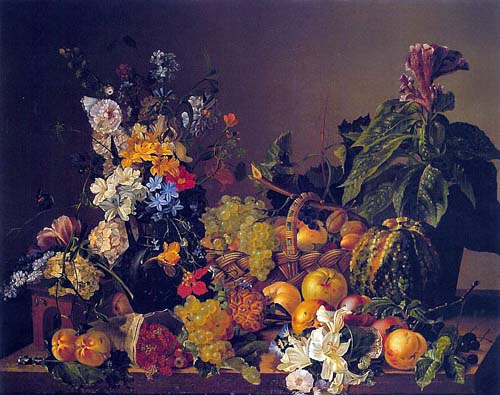
All these trends are visible in Korovin's painting "At the Tea Table" (1888). The canvas depicts a friendly society in the country V.D. Polenova. The painting was painted on the terrace of a country house. The artist is trying to convey the feeling of a summer day, the charm of a friendly conversation. The freshness emanating from the greenery and young faces is created to a certain extent by the still life - the contrast of red poured berries in a white plate, milk in tall transparent glasses, and the whiteness of a fresh tablecloth. The emotional unity of the picture is primarily achieved by the pictorial solution of the canvas. Everything depicted is written taking into account the surrounding light and air environment. In Serov's famous painting " Girl with Peaches" (1887) still life with peaches in the foreground at first glance does not play an important role in the composition of the canvas. All the artist's attention is focused on V. Mamontova, and the fruits only complement the created image. But peaches help Serov solve an important artistic problem. The fruits, according to the artist, serve as a color key to the coloristic construction of the picture. Serov selects his own for peaches yellow and contrasts it with the whiteness of the tablecloth, the greenness of the maple leaves and the yellowness of the light pouring from the window into the garden. The artist distinguishes lemon-yellow, greenish and golden-yellow tones on the uneven sides of the fruit. The tangible light of a summer day, which seems to form peaches, determines the entire emotional and pictorial structure of the picture.
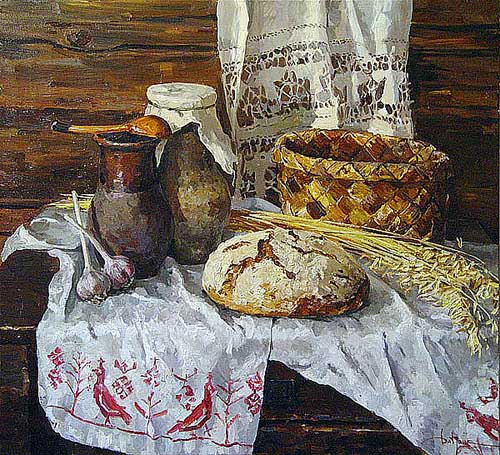
In these works, Serov and Korovin open a new stage in the development of Russian still life. The analytical nature of these paintings is fundamentally different from the concept of a salon still life that existed at that time. The main advantage of such works was considered the maximum similarity of the image with the subject. Etude ease of manner or careful finishing of the picturesque surface was also highly valued. Most accurately, all these principles are embodied in the big picture. K. E. Makovsky "In the artist's studio" (1881). The work impresses with a "still life" heap of details: exotic fruits, rich fabrics, antique rarities. big dog and a little boy do not seem to be living beings, but simple exhibits of this exhibition of luxury goods. The new concept of still life assumed a comprehensive expansion of the boundaries of the genre and its merger with portrait, landscape, interior and household painting. Still life ceases to be a simple image of "dead nature" and turns into a means of revealing the image.

New trends are visible in the famous painting V.D. Polenov "Sick" (1886). The interior and the figure of the heroine are immersed in a deep shadow - they are just a background, and the meaning of what is happening is revealed with the help of a compact group of objects, which is brightly lit by a lamp with a green shade. This still life is very informative. A half-burnt lampshade is snatched out of the darkness by crumpled pillows and sheets, a glass decanter, a glass of water, vials of medicines and doctor's prescriptions. On the left, shabby books in red and blue covers are visible, perhaps these are home remedies or albums that entertained the patient. Such a composition is a symbol of the fact that the whole life of this patient is centered around this table and the objects standing on it. At work, still life is given an active role in creating mood. Also quite characteristic is the still life, which is highlighted in the picture K. Makovsky "Alekseich". In the picture, the figure of a man is already depicted in the background, behind a still life. The image of a benevolent old man is revealed in the sincere joy with which he anticipates his lonely tea party. A crust of bread, a boiling samovar, jam in a glass jar, a box of sugar and tea carefully covered with a towel - all this creates a feeling of peace and warmth, which sincerely pleases an unpretentious person.
Still life as an independent genre of painting finally took shape in the 17th century. in the work of Dutch and Flemish artists.
Until that time, it was not an independent genre, but was only included in other genres as a frame for other paintings (for example, flower garlands), decoration of furniture, interior, etc.
Term
The word "still life" in French means "dead nature" (nature morte). Flowers in a vase is a still life; the same flowers in a flower bed or in the front garden - a landscape. In a broad sense, a still life is an artistic depiction of inanimate objects: plants, game, dishes, etc. The artist does not depict objects “from nature”, as they are located in the interior, but consciously arranges them in such a way as to solve some of his own semantic and artistic task.
Often still lifes contain a hidden allegory through the use of ordinary objects, which the artist endows with a symbol, additional meaning and meaning. An example of an allegorical still life is vanitas (from the Latin vanitas "vanity, vanity").
Varieties of still life
Vanitas

Michael Conrad Hirt. Vanitas
Vanitas is an allegorical still life. Usually on it, among other things, a skull is depicted. Such a still life is intended to remind of the transience of life, the futility of pleasures and the inevitability of death - reflections on the meaning of human existence. The term is taken from a verse from the Bible: "Vanity of vanities, said the Ecclesiastes, vanity of vanities, all is vanity!" In Latin it sounded like this: Vanitas vanitatum dixit Ecclesiastes vanitas vanitatum omnia vanitas". You can read more about vanitas.
Dutch still life
Dutch still life, which took shape in the 17th century. as an independent genre, influenced the further development of all European painting. It turns out that ordinary objects also live, but their life is quiet and invisible to humans. There is some mystery in this. Apparently, this is why the genre of still life became popular and has survived to this day. Sometimes a still life attracts the eye, excites feelings, it is impossible to tear oneself away from it - some associations, fleeting memories arise ...
flower still life
This type of still life is perhaps the most common and the very first to separate into a separate genre.

Jan Davids de Heem (1606-1684). Still life with flower vase (circa 1645). National Gallery of Art (Washington)
Traditionally, many flowers were grown in the Netherlands, gardens were bred, so flower still lifes were a natural extension of society. The very first artists of this genre were Ambrosius Bosschaert the Elder (1573-1621) and Balthasar van der Ast (1593-1657).

Ambrosius Bosschaert the Elder "Tulips, roses, white and pink carnations, forget-me-nots and other flowers in a vase" (circa 1619). Oil on copper
Scientist still life
The most intellectual kind of still life. In such still lifes, reflection on the depicted was supposed, and for this - knowledge of the Bible and other knowledge about the world. Vanitas can also be included in this category, but the scientific still life is broader in subject matter: it contains books, musical instruments, etc.

Maria van Oosterwijk. Still life

D. Annenkov "Reflections with Baudelaire"
Still life in Russian painting
In Russia, still life as an independent genre appeared at the beginning of the 18th century. But for some time (almost late XIX c.) still life was considered a lower genre and depicted only flowers and fruits.
A famous artist of this genre in the XIX century. was I. Khrutsky.

I. Khrutsky. Still life with vase (1832)
![]()
I. Khrutsky "Flowers and Fruits" (1838)
In the twentieth century Russian still life painting has become equal among other genres. Artists worked on the perfection of color, form, composition, the genre began to develop rapidly.
Famous Russian and Soviet artists who worked and still work in the still life genre: Konstantin Korovin (1861-1939), Igor Grabar (1871-1960), Pyotr Konchalovsky (1876-1956), Kuzma Petrov-Vodkin (1878-1939), Martiros Saryan ( 1880-1972), Ilya Mashkov (1881-1944), Elena Skuin (1909-1986), Peter Alberti (1913-1994), Sergei Osipov (1915-1985), Evgenia Antipova (1917-2009), Viktor Teterin (1922- 1991), Maya Kopyttseva (1924-2005), Yaroslav Krestovsky (1925-2003), Vladimir Stozharov (1926-1973), Boris Shamanov (1931-2008) and others.

E. Skuin "Peonies and Cherries" (1956)

V. Stozharov. Still life with rowan (1969)
Still life in various styles and directions of art
The turn of the XIX-XX centuries. known for experiments in the field of artistic creativity. Still life also did not escape this fate. Paul Cezanne, Paul Gauguin, Henri Matisse and others were the first to experiment with still life.
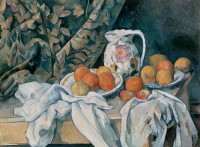
P. Cezanne. Still life with drapery (1889). Hermitage (St. Petersburg)
Feel free to experiment cubist P. Picasso.

P. Picasso "Jug, glass and book" (1908)
J. Braque also worked in the cubist style.

J. Marriage " Musical instruments» (1908)
cubofuturists worked in search of a new space-time dimension.

K. Malevich "Cow and violin" (1913). State Russian Museum (St. Petersburg)
His "... intuitive feeling found in things the energy of dissonances obtained from the meeting of two opposite forms" (K. Malevich "From Cubism and Futurism to Suprematism").
In the metaphysical still lifes of Giorgio Morandi (1890-1964), objects are pressed against each other, forming dense groups, as if trying to keep warm, fearing external cold and aggression.

Giorgio Morandi. Natura Morta (1956)
The most famous representative surrealism Salvador Dali in his famous work "The Persistence of Memory", which is essentially an allegorical still life, reflects on the relativity of time.

S. Dali "The Persistence of Memory" (1931)
Commercial advertising of the second half of the XX century. brought up in people a greedy attitude to things and insatiable consumption. There is a fetishization of the subject. Elements of the still life genre are beginning to transform from art into a source of consumption.

Andy Warhol Campbell's Soup Can (1968)
Dmitry Krasnopevtsev represents Russian "unofficial" art, although he has a completely official classical art education (he graduated from the Moscow Art Institute named after V. I. Surikov).
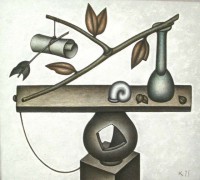
D. Krasnopevtsev. Still life
Krasnopevtsev's main genre is a "metaphysical still life" close to surrealism with simple, often beaten ceramics, dry plants and shells. These works, painted in ashy tones, develop the motif of the frailty and unreality of the world.
Here are the still life paintings contemporary artist Dmitry Annenkov are quite "animated". They are different: joyful, sad, funny, but quite alive. They want to be touched. Looking at these still lifes, it is impossible to resist a kind smile.
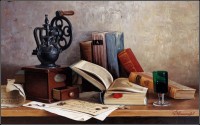
D. Annenkov "Still life with a coffee grinder"

D. Annenkov "Spring Sun"

D. Annenkov "Memories of Summer"
Still life as an independent genre of painting appeared in Russia at the beginning of the 18th century. The idea of him was originally associated with the image of the gifts of the earth and the sea, the diverse world of things surrounding a person. Until the end of the 19th century, the still life, in contrast to the portrait and historical painting, was considered as a "lower" genre. It existed mainly as an educational production and was allowed only in a limited sense as a painting of flowers and fruits.
Ivan Khrutsky "Flowers and fruits" 1839
The beginning of the 20th century was marked by the flourishing of Russian still life painting, which for the first time gained equality among other genres. The desire of artists to expand the possibilities of the pictorial language was accompanied by active searches in the field of color, form, and composition. All this is especially evident in the still life. Enriched with new themes, images and artistic techniques, the Russian still life developed unusually rapidly: in a decade and a half it goes from impressionism to abstract form creation.
Then in Russia there were many art associations.

Nikolai Sapunov "Flowers and vases on a pink background", 1910
A bright artist, a master of theatrical compositions and exotic still lifes, N. Sapunov had a very peculiar color talent. During the period of writing the still life "Flowers and Vases on a Pink Background" Nikolai Sapunov was a member of the Blue Rose symbolist association. The poetics of symbolism attracted artists to romantic-occult themes.
A. Blok singled out in his work the search for color rhythm, color music, color drama that would correspond to the drama of those performances for which he painted scenery.
Prone to the bohemian life, the artist once sailed with a company in a boat on the Gulf of Finland, and drowned at the age of 32.
Pyotr Konchalovsky was a member of the "Jack of Diamonds" association. This association is characterized by the search for new pictorial and plastic solutions, the deformation and dismemberment of form, the texture of painting, the identification of form and volume by color, the desire for painting the sensual, material and colorful side of life. The ideological origins are the so-called "Russian Cezannism", Russian folk art (lubok, icon, tile, murals, trade signs).

P. Konchalovsky "Red Tray", 1913
Enlargement, roughening, but making every thing dense and strong - this is the task of the young Konchalovsky in his numerous still lifes, where it is no coincidence that the same market tray often appears as a kind of tuning fork, setting painting the necessary level of coloristic tension. The color here conveys not so much a surface coloring as the very form and mass, the material flesh of things.
![]()
Ilya Mashkov "Snedd Moscow"
Scandalous fame accompanied the young Ilya Mashkov - a gambling and enterprising nugget who gained life experience "in people" (working in shops for merchants), who passed "universities" in European museums, but was expelled in 1909 from the walls of the MUZHVZ (Moscow School of Painting Sculpture and architecture). However, while still studying, Mashkov taught with great success himself - his studio (1904-17; in 1925 it was transformed into the Central Studio of the AHRR) was the most expensive and at the same time the most visited in Moscow.

Ilya Mashkov "Still life with a horse skull", 1914
Having struck the audience and critics with the "barbaric" pressure of his painting at the exhibitions "Golden Fleece" and "Izdebsky Salon" (1909-10), Mashkov found his place among the artists who made up the "Jack of Diamonds" society (P. P. Konchalovsky, A. V. . Lentulov and others). "Jacks" affirmed the materiality of the world and the "low" object; the generosity and majority of Mashkov's palette, the abundance of his still life productions turned out to be consonant with the program of the association.
In an effort to return art "from heaven to earth", the artists of this circle focused on the "craft" - a street sign, a tray, a popular print. Mashkov was familiar with such a craft from childhood, and the primitivism of his still lifes and portraits is the most ingenuous and genuine.

Ilya Mashkov "Still life with fruit"
Painter, in love with "the bright flesh and blood of things." This life-affirming, realistic, optimistic attitude turned out to be the most suitable for the new tasks of art. A clear view of the world, the look of a working person, rejoicing in the work itself and celebrating its results, is characteristic of the artist in the post-revolutionary years. Mashkov has his own special understanding of the relationship between object and space in painting, and his pathos is in affirming the healthy reality of the subject by enhancing its plastic and color characteristics.
Heightened attention to the inherent value of objects allowed the painter to discover new expressive possibilities in simple, familiar things.

Ilya Mashkov "Copper dishes"
In "Still Life with a Samovar (Copper Ware)" (1919), kitchen utensils - a coffee pot, a milk jug, a mug, a plate, an iron, trays - rallying together and pushing space to the periphery of the canvas, resemble a small, but strong army in its unity and confidence. Restrained, almost monochrome color scheme highlights the chased forms of objects, conveys their soft, but strong brilliance. Each thing appears in its brightly individual appearance, but all of them are united by some kind of almost "ideological" commonality - belonging to the same "class", the material - copper. This is the apotheosis of the beauty of modest metal, and it sounds loud, solemn, powerful. Sovereign, copper objects are weighty, and the viewer, subdued by the restrained power emanating from them, forgets about their purely domestic purpose.
Petrov-Vodkin's still lifes are unpretentious in terms of their set of objects and bear signs of the harsh era in which they were created. In this sense, a still life depicting a skinny herring, a piece of bread and two potatoes, a meager ration of famine, has become a classic.
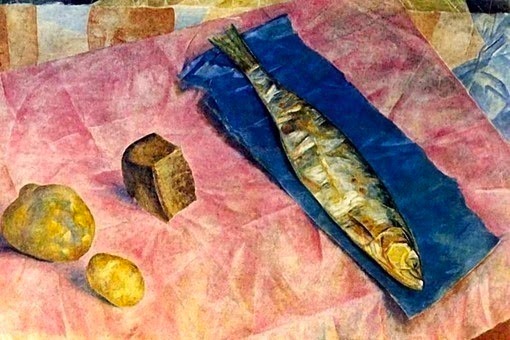
Kuzma Petrov-Vodkin "Herring", 1918
The artist likes to introduce mirrors, glass or just some shiny objects (samovar, nickel-plated teapot) into them, allowing him to devote himself to the analysis of the complex game of reflexes, refractions of beams of light incident and reflected in the inner faces. In these studies, in the spirit of Vrubel, Petrov-Vodkin replaces the passion of his brilliant predecessor with a methodically persistent desire to know the subject in all its aspects.

Kuzma Petrov-Vodkin "Still life with an inkwell", 1918
The artist examines the things laid out and placed on the table from above, so that their location lends itself to precise fixation and they are visible "as in the palm of your hand"; the polished edges of the teapot or the glass-covered surface of the table double the image, allowing you to look at it from the side invisible to the artist. Thus, Petrov-Vodkin overcomes the monocular point of view, which seems to him insufficient and does not reflect the true knowledge of the subject, which can be walked around, eventually getting a total and more complete idea of it.
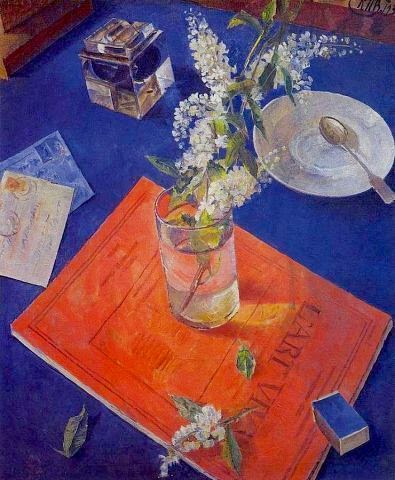
Kuzma Petrov-Vodkin "Bird cherry in a glass", 1932
The most striking thing in all the still lifes of Petrov-Vodkin is that the close, sometimes scrupulous analysis of objects and the strict, almost experimental compositional structure of the canvas in no way deprive them of the immediacy of the artistic perception of nature, not to mention the richness and subtlety of color. The special clarity of the image, in which the objects are as if named in turn and do not obscure each other, gives rise to an almost physical feeling of joy from the contemplation of these still lifes, such as if simple and so, in essence, difficult, as Petrov’s art is far from simple and unambiguous -Vodkin.
Understanding the world as a large still life, as a combination of tangible and material colorful textures, he did not turn to the radical forms of the avant-garde - stopping, as it were, on the threshold of cubism - or to the lubok-folklore primitive.

A. Kuprin "Still life with a blue tray", 1914
The works of his early period are dominated by intense colorful contrasts, nature is perceived as if tactile and objective and at the same time quite alienated.

Zinaida Serebryakova "Still life with attributes of art"
This work by Serebryakova has a traditional composition for the artist. As is customary in works with a similar name, an antique mask is depicted here, there is a box with paints, a roll of paper resembling a scroll, glass bottles with pigment powders for paints and a light ceramic mortar are located in the background. Still lifes on the "production theme" are often found in the work of artists.
In 1913, P. Konchalovsky painted the painting “Dry Paints”, which clearly shows the artist’s interest in combining bright pigments: orange with cobalt, ocher with scarlet.

P. Konchalovsky "Dry colors", 1913
The canvas is made in a rough, simplified manner. Serebryakova's painting is softer, more tactful. In books, in brushes stained with paint, in sheets of drawing paper left on the table, the warm touch of the artist's hands lives, love trembles, keen interest, attachment to the constant and reasonable helpers of his work. And perhaps it is precisely in this: in the humanity of the objective world, in its visible connection with people, that the interpretation and assessment that Zinaida Evgenievna gives to reality are most fully revealed. She is connected with the world of objects by a deep inner community, things serve her like good old servants, well known in their unchanging and useful qualities. Serebryakova's world is revealed to us full of even, clear, warm light and harmony.
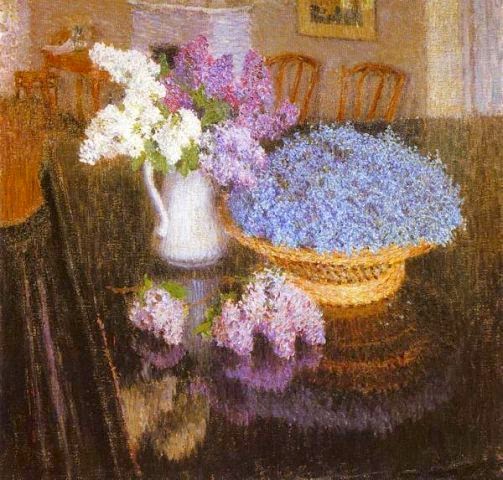
Igor Grabar "Lilac and forget-me-nots"
It was then that Grabar was fond of the painting method of Claude Monet. "Chrysanthemums" are extremely typical in this respect. The color analysis of the vibrating light-air medium is close to some searches of French painters of this direction.

Igor Grabar "Chrysanthemums"
The artist is looking for a way out in the subordination of forms and colors to a certain decorative rhythm. Very soon, this overcoming of the well-known limitations of the impressionistic method becomes consistent with Grabar. The artist sets still lifes for the purpose of a special analysis of the color, shape, and materiality of the object. Grabar's still lifes are marked by the variety and complexity of the tasks set, the search for new artistic techniques. This is no coincidence. Everything here speaks of the proximity of a new stage in the development of Russian still life. In the atmosphere of the struggle for new artistic forms, which permeated the painting of the 1900s, still life becomes one of the leading genres, an arena for creative experimentation.
In the 1930s and 1940s, the development of still life stopped, but since the mid-1950s this genre has been experiencing a new upsurge in Soviet painting, and from that time on it finally and firmly stands on a par with other genres.






